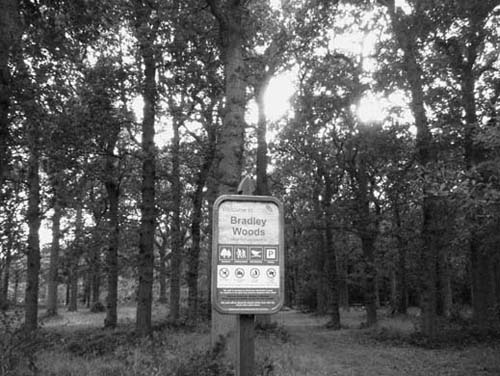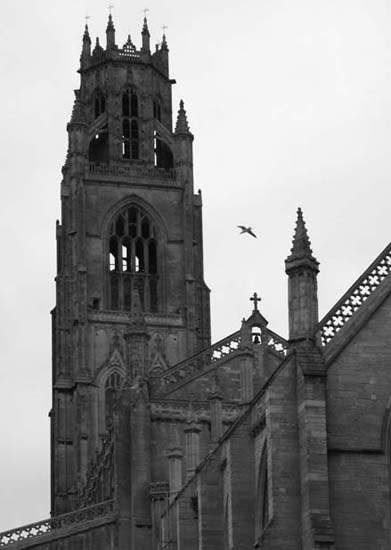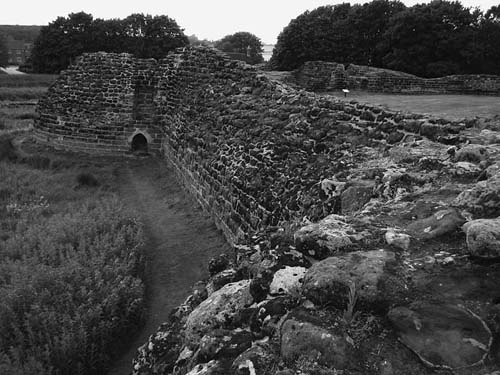Folklore of Lincolnshire (18 page)
Read Folklore of Lincolnshire Online
Authors: Susanna O'Neill

The reputedly haunted Harmston Hall, Waddington. This is now a private house.

Irby Dale Woods is a large and picturesque wood to visit. There is a small car park by the road at Irby upon Humber and then a fairly long walk to the trees across farmland, but the public path is well maintained.

Bradley Woods, furnished with car parking facilities, is a pretty nature reserve well worth a visit, even if you see nothing of the Black Lady!
Bradley Woods is another Lincolnshire wood that is reputedly haunted. It is here that the ghost of the Black Lady roams, searching for her lost love and the baby that was snatched away from her. She is said to be of average height, very pretty and wearing a long, flowing black cloak with a hood. Her face is ghostly pale and grief-stricken but although she is shocking to behold, she is said not to hurt anyone.
The story goes that she was a beautiful woman in life, happily married to a woodsman and living in a cottage in the woods. They had a baby together on whom they both doted, but one day the husband was called away to fight in the War of the Roses. The wife missed him terribly and pined for him, circling around the wood every day watching for him to return. One day, some enemy soldiers entered the woods and found her, alone and helpless. They assaulted her and stole her baby, leaving her with nothing. Half mad with sorrow, she wandered incessantly in search of her missing baby as well as her absent husband. She never saw either again and died of a broken heart. Her restless spirit continues to search for them still. The sightings of her were so common that mothers used to use her story to frighten their children: ‘If yer don’t stop yer awming the Black Lady’ll get yer!’
There have been modern sightings of the Black Lady and some people have reported seeing the leaves on the path in front of them moving, as if someone were walking across them. There is also a myth that if you visit the wood on Christmas Eve and shout out to her ‘Black Lady, Black Lady, I’ve stolen your baby!’ three times, she will appear ready to rescue her child. This would be a heartless game, for the story is sad enough and one can only hope she may find peace.
There are more stories of hauntings connected with love, such as the Lady in Green, who is said to be seen in Thorpe Hall. When the owner of the hall, Sir John Bolle, was abroad in the 1500s, a Spanish lady fell in love with him and wanted to marry him. Unfortunately he already had a wife in England, so as a symbol of her love for him the Spanish girl gave him a picture of herself for him to take home. It would seem that her everlasting love for him was somehow caught up in the picture and her spirit has been seen wandering the hall ever since.
There is also a headless bride, which Fisk states haunts Scremby late at night;
8
rather a frightful sight, and one can only imagine what occurred on her wedding night!
Another is the story of a ghostly figure of a young woman, Sarah Preston, married to a local ship owner, who has been seen to jump from the Boston Stump tower, holding a baby in her arms, but then vanishing before hitting the ground. Legend states that in 1585, she had an affair with a sailor from whom she contracted the plague, which then infected the rest of the village, claiming the lives of hundreds of people in Boston. She was driven to suicide by the angry mob.
There is an alternative story about the ghostly figure seen to jump. The woman was thought to be happily married, yet lost her husband not long after giving birth
to their child. She was so grief-stricken that she took the baby and threw herself off the Stump Tower, hoping for a reunion with her beloved. The lady is actually supposed to appear if you run around the Stump three times at the stroke of midnight.
The list for lovelorn ghosts could continue but there is a plethora of other ghostly happenings in Lincolnshire that also deserve a mention.
One rather strange ghostly apparition is that of a hare at Bolingbroke Castle. The castle is now a ruin but open to the public, so you can search for the hare yourself. It is a wily, timeless creature, evading capture by any means, as this extract from
The Gentleman’s Magazine
in 1821 illustrates:
One thinge is not to be passed by affirmed as a certaine trueth by many of the inhabitants of the towne upon their owne knowledge, which is, that the castle is haunted by a certain spirit in the likenesse of a hare; which att the meeting of the auditors doeth usually runne between their legs, and sometimes overthrows them, and soe passes away. They have pursued it downe into the castleyard, and seene it take in att a grate into a low cellar, and have followed it thither with a light, where notwithstanding that they did most narrowly observe it [and that there was noe other passage out, but by the doore, or windowe, the roome being all close framed of stones within, not having the least chinke or crevice] yet they could never finde it. And att other tymes it hath been seene run in at iron-grates below into other of the grotto’s [as there be many of them] and they have watched the place, and sent for houndes and put in after it; but after a while they have come crying out.
9
There have long been tales of hares throughout the world, with links to the moon and as creatures belonging to witchcraft or even disguised as witches. Ghost hunter Rod Collins
10
affirms that Bolingbroke Castle was once used to hold a witch and states that the apparition is her ghost.
There is the tale of another hare-like creature being seen along the road between Kirton and Grayingham, thought possibly to be a nineteenth-century haunting, based on the story of a murder that happened there. Rudkin presents the account of one B. Willoughton, who tells that a man named Copeman was murdered by one Trafford in this place, and Trafford is said to have laid the body out in the field by the edge of the lane. Since then, grass is supposedly never able to grow where Copeman’s head and heels touched the ground.
But there is something in the ‘auntin’ there…One night me an’ a pal ‘ad been to Kirton…we was bicyclin’ back, an’ when we got to that bit ‘o road…there was a man a- ‘orse-back comin’ at us up the road. Now, whether we went through ‘im; or if we didn’t, where ‘e went to I don’t know! But we came ‘ome like greased lightnin’ after that, I can tell yer!
Rudkin goes on to narrate the sighting of the hare-like creature running down this road: ‘It was mostlins as big as an owd ‘are, but with two ‘orns an’ only two feet, an’ its feet clattered on the road.’
11
This description sounds more like a devilish imp than a hare – perhaps it is just another manifestation of the ghostly presence, like the phantom horseman.

The Boston Stump.

The picturesque ruin of Bolingbroke Castle, surrounded by ponds and greenery. It is well signposted and easily found.
An additional animal spectre is that of a sow with piglets. In some legends, the sighting of a phantom sow with her litter was a sign that alms to the poor had not been paid. Once they were paid as they were supposed to be, the sightings stopped. It seems unlikely that this was the cause of this particular spectre, however, as she appeared regularly every Halloween along Bonnewells Lane, Bransby. Rudkin tells us the lane is badly haunted, with sightings of a Black Dog and also a lady with a rustling silk dress; an interesting place for a ghost hunter to visit!
At Gunthorpe, Commonpiece Lane, there have been numerous sightings of a large, white phantom cat. One story tells of a local man returning home on a snowy night when he saw the cat. He apparently kicked at it, and it vanished into thin air. The next morning he returned to the spot and as no more snow had fallen that night, his own footsteps could clearly be seen in the snow. He could even see where he had kicked out at the cat, but there were no traces whatsoever of the cat’s paws. Legend states that human bones have been discovered in this place, although no answer was ever forthcoming as to who the unfortunate person was, nor how they met their demise. Ghost cats are a fairly common sighting, some believing them to linger where their loyalties once lay, as a kind of protector. This is one possible explanation for the ghost cat at Gunthorpe.
Moving away from animal spectres, Christopher Marlow regales us with the wonderful tale of the ghosts of All Saints’ Church, at Holbeach. He tells of four firm friends who, in the late seventeenth century, regularly met at the Checquers to play cards into the early hours. Unfortunately, one of the four friends, farmer John Guymer, was struck down with a serious illness and died within in a few days. The other three were distraught at losing their card partner:
‘Alas now we shall play no more’ said one. ‘Farmer Guymer is dead and there is no one to take his place.’ ‘Say not so…’ answered the second. ‘Let us drink confusion to the Devil who has fetched him and pray for another partner to join our game.’
12
On the night of his funeral, the remaining men continued to drink and chatter late into the night, until they became so inebriated that they decided to go and visit their friend in the churchyard. One had the terrible suggestion of having a game of cards as of old, with their dead friend, and so they dug him up and all four entered the church ready to play. They propped old farmer Guymer against the rails and took it in turns to guide his hand in the game, jeering and bellowing every so often and having not a thought of reverence. They continued thus into the small hours, when suddenly there was a hideous booming laugh all around them. Their dead friend disappeared and in his place sat the Devil, who smiled as he uttered a warning for them to save themselves. Then just as suddenly as he had appeared, he vanished and farmer Guymer was back in his stiff position. The three men convinced themselves it had been a trick of the light, a drunken hallucination. They continued to play, taunting the dead man for his game but alas, there was eventually a horrendous shriek and three grisly phantoms appeared and sped towards them. Each phantom seized a man, grabbing him tightly and then vanishing with him. Only poor farmer Guymer, left propped up against the rails, was found in the morning when the villagers ventured into the church to discover the source of the screams of the night before. Legend says a sly smile of victory played upon his lips. Forever afterwards, the villagers of Holbeach testified that the ghosts of the three men would stand in the doorway of the church at night, with the stiff corpse of their dead friend, ‘and beckon all drunken men to their doom’.
